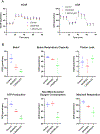Photoprotective Properties of Vitamin D and Lumisterol Hydroxyderivatives
- PMID: 32441029
- PMCID: PMC7347247
- DOI: 10.1007/s12013-020-00913-6
Photoprotective Properties of Vitamin D and Lumisterol Hydroxyderivatives
Abstract
We have previously described new pathways of vitamin D3 activation by CYP11A1 to produce a variety of metabolites including 20(OH)D3 and 20,23(OH)2D3. These can be further hydroxylated by CYP27B1 to produce their C1α-hydroxyderivatives. CYP11A1 similarly initiates the metabolism of lumisterol (L3) through sequential hydroxylation of the side chain to produce 20(OH)L3, 22(OH)L3, 20,22(OH)2L3 and 24(OH)L3. CYP11A1 also acts on 7-dehydrocholesterol (7DHC) producing 22(OH)7DHC, 20,22(OH)27DHC and 7-dehydropregnenolone (7DHP) which can be converted to the D3 and L3 configurations following exposure to UVB. These CYP11A1-derived compounds are produced in vivo and are biologically active displaying anti-proliferative, anti-inflammatory, anti-cancer and pro-differentiation properties. Since the protective role of the classical form of vitamin D3 (1,25(OH)2D3) against UVB-induced damage is recognized, we recently tested whether novel CYP11A1-derived D3- and L3-hydroxyderivatives protect against UVB-induced damage in epidermal human keratinocytes and melanocytes. We found that along with 1,25(OH)2D3, CYP11A1-derived D3-hydroxyderivatives and L3 and its hydroxyderivatives exert photoprotective effects. These included induction of intracellular free radical scavenging and attenuation and repair of DNA damage. The protection of human keratinocytes against DNA damage included the activation of the NRF2-regulated antioxidant response, p53-phosphorylation and its translocation to the nucleus, and DNA repair induction. These data indicate that novel derivatives of vitamin D3 and lumisterol are promising photoprotective agents. However, detailed mechanisms of action, and the involvement of specific nuclear receptors, other vitamin D binding proteins or mitochondria, remain to be established.
Keywords: DNA damage; Lumisterol; Oxidative stress; Skin; Ultraviolet B; Vitamin D.
Conflict of interest statement
Conflict of Interest:
The authors declare that they have no conflict of interest.
Figures







Similar articles
-
Protective effects of novel derivatives of vitamin D3 and lumisterol against UVB-induced damage in human keratinocytes involve activation of Nrf2 and p53 defense mechanisms.Redox Biol. 2019 Jun;24:101206. doi: 10.1016/j.redox.2019.101206. Epub 2019 Apr 20. Redox Biol. 2019. PMID: 31039479 Free PMC article.
-
Hydroxylumisterols, Photoproducts of Pre-Vitamin D3, Protect Human Keratinocytes against UVB-Induced Damage.Int J Mol Sci. 2020 Dec 9;21(24):9374. doi: 10.3390/ijms21249374. Int J Mol Sci. 2020. PMID: 33317048 Free PMC article.
-
Detection of 7-Dehydrocholesterol and Vitamin D3 Derivatives in Honey.Molecules. 2020 Jun 2;25(11):2583. doi: 10.3390/molecules25112583. Molecules. 2020. PMID: 32498437 Free PMC article.
-
Novel non-calcemic secosteroids that are produced by human epidermal keratinocytes protect against solar radiation.J Steroid Biochem Mol Biol. 2015 Apr;148:52-63. doi: 10.1016/j.jsbmb.2015.01.014. Epub 2015 Jan 21. J Steroid Biochem Mol Biol. 2015. PMID: 25617667 Free PMC article. Review.
-
The Role of Classical and Novel Forms of Vitamin D in the Pathogenesis and Progression of Nonmelanoma Skin Cancers.Adv Exp Med Biol. 2020;1268:257-283. doi: 10.1007/978-3-030-46227-7_13. Adv Exp Med Biol. 2020. PMID: 32918223 Free PMC article. Review.
Cited by
-
Consideration of possible effects of vitamin D on established cancer, with reference to malignant melanoma.Pigment Cell Melanoma Res. 2022 Jul;35(4):408-424. doi: 10.1111/pcmr.13040. Epub 2022 May 11. Pigment Cell Melanoma Res. 2022. PMID: 35445563 Free PMC article. Review.
-
Revisiting the role of melatonin in human melanocyte physiology: A skin context perspective.J Pineal Res. 2022 Apr;72(3):e12790. doi: 10.1111/jpi.12790. J Pineal Res. 2022. PMID: 35133682 Free PMC article. Review.
-
Vitamin D and COVID-19: An Overview of Recent Evidence.Int J Mol Sci. 2021 Sep 29;22(19):10559. doi: 10.3390/ijms221910559. Int J Mol Sci. 2021. PMID: 34638897 Free PMC article. Review.
-
Vitamin D-metabolizing enzyme CYP24A1 affects oncogenic behaviors of oral squamous cell carcinoma and its prognostic implication.Med Mol Morphol. 2024 Sep;57(3):185-199. doi: 10.1007/s00795-024-00387-y. Epub 2024 May 21. Med Mol Morphol. 2024. PMID: 38772955
-
Novel Vitamin D3 Hydroxymetabolites Require Involvement of the Vitamin D Receptor or Retinoic Acid-Related Orphan Receptors for Their Antifibrogenic Activities in Human Fibroblasts.Cells. 2024 Jan 26;13(3):239. doi: 10.3390/cells13030239. Cells. 2024. PMID: 38334631 Free PMC article.
References
-
- Holick MF & Clark MB The photobiogenesis and metabolism of vitamin D. Fed Proceed 37, 2567–2574 (1978). - PubMed
Publication types
MeSH terms
Substances
Grants and funding
LinkOut - more resources
Full Text Sources
Research Materials
Miscellaneous

